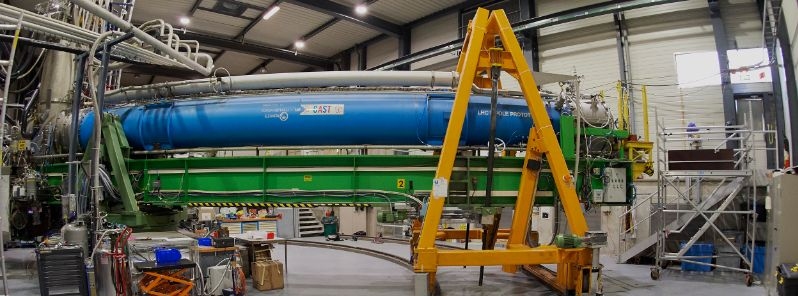Exotic particles as the Sun aligns with the center of the Milky Way

As the Sun made an annual alignment with the black hole at the center of the Milky Way galaxy on December 18, 2016, the scientists at CERN carried out the first of a kind experiment to measure hypothetical exotic particles possibly emitted by the black hole.
The research team utilized the CERN Axion Solar Telescope's (CAST) prototype dipole magnet to measure the axions and chameleons which may be emitted from the center of the black hole. This is the first of a kind experiment, as there was no previous attempt at measuring the particles, until now.
“We’ve always looked for exotic particles from the Sun, we have been doing this for years, but for one specific day we can look beyond the Sun, to see if something more happens,” said Konstantin Zioutas, spokesperson for the experiment.

The CAST telescope, made of a prototype dipole magnet from the Large Hadron Collider. It moves along the tracks on the ground to follow the Sun's movement across the sky. Image credit: Maximilien Brice/ CERN
The existence of the hypothetical particles holds the potential for explaining the dark matter and dark energy, the major current problems of physics. The Sun's alignment with the galaxy's central black hole has provided the scientists an opportunity to use the star's gravitational force to focus the slow, exotic particles, in the so-called gravitational lensing phenomenon.
“The galactic center might send out exotics that we can detect now, which might tell us far more about the dark universe than we could know before, since the Sun can amplify a faint exotic stream by about one billion, provided it is aligned with the Sun-Earth system,” explained Zioutas.
It's not the first the scientists made an attempt in measuring exotic particles from a black hole. However, it is the first attempt to measure the interaction of the particles with the magnetic field of the CAST magnet and with the INGRID detector. The scientists are also hoping this might be the first time to measure the particle's interaction directly with matter.

Timelapse video of CAST following the Sun in the morning and in the evening. Video credit: Madalin-Mihai Rosu/CERN
“Until now, it’s been impossible to detect particles through their specific direct interaction with the matter because the equipment didn’t exist. We had to build a special detector, called KWISP (Kinetic Weakly Interacting Slim Particle detector),” said Giovanni Cantatore, deputy spokesperson for CAST.
To be able to detect such interactions, the scientists have utilized special equipment to detect tiny forces produced when chameleons bounce off the matter.
“KWISP uses a special membrane force sensor – like the skin of a drum. When it’s hit by the chameleons, it vibrates at a frequency we can fix using the ‘chameleon chopper’, a device we invented for this purpose,” explained Cantatore.
The researchers are currently analysis the collected data. The early resuls indicate no additional new particles have been emitted from the black hole. The scientists will soon start to prepare for the alignement which will also include the Moon, and will occur next year.
“The experiment performed very well and discussions on the first on-line data have already started,” concluded Zioutas.
Featured image: The CAST telescope, made of a prototype dipole magnet from the Large Hadron Collider. It moves along the tracks on the ground to follow the Sun's movement across the sky. Image credit: Maximilien Brice/ CERN

Wow, the sun made is annual alignment with the milkyway. There is a huge problem where at first glance Dr Phil must have wrote this as the basic understanding of grade school science seems to be a fantasy to this writer who obviously works for CERN. The second glance tells us that the axis of evil phenomenon that CERN and religion of Cosmology struggle with, would be the correct interpretation. Either way, it appears that CERN is incapable of communicating fact.